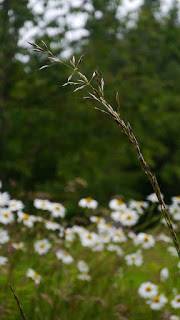On yesterday's trundle up the hill for a fresh supply of chanterelle mushrooms, as well as my collecting basket I took a tape measure (the wee black thing in the basket) to measure a very tall foxglove by the top fence. On the way I noticed how good the bramble flowers were looking. Later in the year I'll be collecting blackberries.
 |
a pinkish bramble flower,
Rubus fruticosus |
On Friday Toadlet and I had got the train to Glasgow. She needed clothes. Both going and coming back I'd noticed how splendid the brambles were looking along the railway track. How fortunate that we have a local supply too!
Below is the foxglove in question, not the one that's keeled over – a few of them have done that in the last few days of strong winds – but the tallest one behind it with a backdrop of grey sallow. The keeled over one is two metres long anyway, but the still standing one I measured, with difficulty, to be about two hundred and twenty centimetres.

Yesterday evening Toad asked me to show him where the chanterelles were growing, which I did. We also found another patch of them on our side of the burn. It is unlikely that anyone else knows about these chanterelle patches – our own private supply! Getting back to yesterday morning... while Toads and Toadlets of the Boggy Brae slumbered on, and having collected chanterelles sufficient for the day, I noticed, in usual wellywander fashion, other small things on my trundle home.
First, some signs of deer nibblings. On a young downy birch to the left, on grey sallow below,
 |
| Bark (and moss and lichen?) eaten off a grey sallow branch |
followed by some Peruvian Lily flowers and leaves. In parts of Scotland where forest regeneration is being attempted but where the deer populations are too large, the deer-nibblings of tree bark prevent trees from flourishing. I think this is why there is
talk of rewilding by introducing predator species such as lynx that will keep the deer population in check and so allow a better ecological balance.
Swishing through wet grass, I came to the flowering Hypericum shrub. It is not Tutsan. Flowers of Tutsan are smaller. And it's not Rose of Sharon (there is some of that elsewhere), but some other species whose name I don't know. Whatever it is, it's looking good right now.
As is the pale Escallonia a little lower down the garden.
 |
Escallonia virgata, possibly, a plant native to
southern Chile and Argentina |

One of the things I like finding in the Boggy Brae garden is small communities of plants, like this one of self-heal, broad-leaved willowherb, and the tiny moss Variable Crisp-moss (Trichostomum brachydontium), all growing on the spruce log that is propping up the loose end of the eucalyptus bench.
Lower still, and across on the south-eastern side of the garden, is this wonderful 'fence' of brambles and honeysuckle growing into the fallen old wild cherry tree.
The honeysuckle flowers are awash with tiny insects.
Over this fence in the field, lesser knotweed (Persicaria campanulata) is growing. It is pretty invasive so I discourage it in the garden though I'm sure various insects like its flowers as well.
 |
| Lesser Knotweed (Persicaria campanulata) |
Lastly, though I know this is well into its flowering period down south, our Black Knapweed is still gathering its flower forces for late July at the Boggy Brae where, as of yesterday, the big Downy Birch near the house is showing its first yellow leaf tinting of autumn. This is not early for here but bang on time. It always starts in July, any day from the fifth of the month onwards by my records.

















































